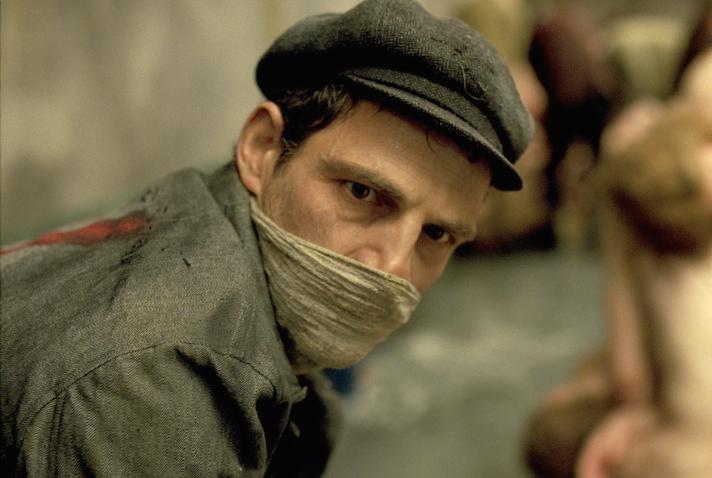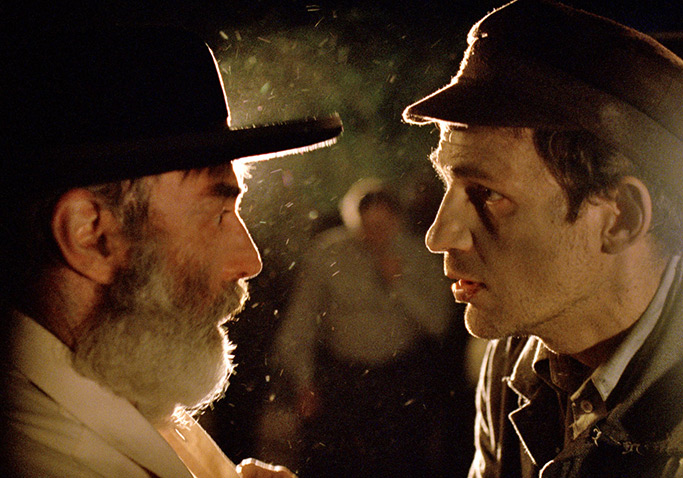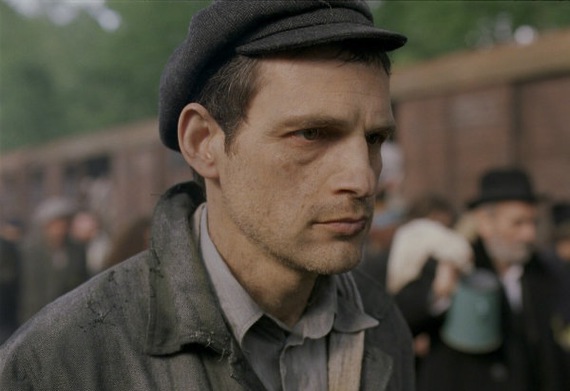There are no establishing shots. No trains arriving at the gates of Auschwitz with their infernal box cars. No dates. No body counts. Instead, first-time director Lazlo Nemes places us right in the midst of the wretched business of the Holocaust. What we see and what we don't see is a product of the perspective of Hungarian-Jewish prisoner, Saul (Geza Rohrig).
The only bit of overview we are given in Son of Saul is a title card explaining the Sonderkommandos, work outfits at death camps composed of Jewish prisoners, often pressed quickly into service upon their arrival at the extermination centers. Saul is one such Sondercommando, very likely at the end of his tenure in the special unit (the translation of the term in German) in 1944. The end of that grim tenure means the end of his life. The Sondercommandos, the "bearers of secrets," were conducted to their own demise, usually within months, by their successors.
Son of Saul does begin in the midst of the ruthless cycle of the Sonderkommandos and the Auschwitz-Birkenau camp. It's not so much that the film commences as if the camera is just turned on at some random point during Saul's time as a Sonderckommando. The camera is a kind of doppelganger to the Hungarian prisoner, often peering over his shoulder, just as often staring him in the face. That face is not quite impassive, not quite numb. But it is like an instrument asked to measure some powerful phenomenon one too many times, frozen in its last flash of activity. Thus, the brown eyes ever dilated, an unceasing aperture. The brow - Mr. Rohrig's imposing brow and piercing dark eyes are reminiscent of a young Peter Boyle - hunched in repeated questioning. The full lips just open, or just closed, having just arrived, just left some expression of incredulity.
The first long, masterful sequence is all the more harrowing for the lack of exposition. It's one of many unrelenting scenes of controlled chaos in Son of Saul. New arrivals are essentially herded into a changing room, directed toward pegs where they are instructed to hang their clothes after stripping. Saul, a red X on his jacket signifying his special status, wordlessly hustles the newcomers to the changing area and then toward what they believe to be a shower room. All the while, announcements can be heard urging the arrivals toward the shower, reminding them to remember the hook number where they've left their clothes, telling them to make haste lest the bowls of soup that await them get cold. Of course, the irony of those latter statements cuts horribly, invisibly through the air.

As soon as the chamber door closes on the victims, Saul and his coworkers go through the pockets of the left clothing for any paperwork or valuables. As we'll find out, the Sonderkommandos sometime take the dangerous step of pocketing (or placing in their shoes) pilfered items of jewelry, each "shiny" a piece of currency in the camp. Much as Saul and those in his unit have prescribed duties, it's not unusual for them to be be pulled away to some other morbid task. So it happens while Saul and the other Sonderkommandos about him are quickly removing evidence of the latest group of arrivals. He's called to press against the metal door of the gas chamber with others while those inside pound and cry out with rising desperation. There is eventually a nightmare cacophony, a crescendo, then silence. With virtually no hesitation, the Sonderkommandos must remove the bodies, the "pieces" as they are called by the presiding Nazis, pile them for delivery to the ovens and then scrub the gas chamber clear of excrement and whatever else remains.

By this most perverse stream of consciousness, Mr. Nemes and his co-writer Clara Royer reveal bits of information about the camp. There is the nearly constant, dreadful flow of humanity and all the tasks attendant to getting the victims in place and their subsequent disposal. Much as the movement of Saul and the story are nearly constant, we do observe the Sonderkommandos in stolen bits of respite, moments of conversation and conspiracy. We see their barracks, completely separate from other death camp inmates. As compensation for their dire labors, the Sonderkommandos enjoyed some measure of privacy, a more sustaining diet and even things like cigarettes, plucked from the clothing of those who would not need them any longer.
There is also a sense of the politics of the place, the give and take between units and an awareness that the often brutal Kapos must be given their deference or avoided altogether. Implicit in all of this is the cryptic nature of those politics to an outsider or newcomer. How quickly choices would have to be grasped which basically involve some previously unimagined compromise of humanity or almost immediate death. Obviously, it was a momentum that served the camps and the Nazis all too well.

Saul's particular momentum is diverted by a kind of miracle. After the first group of victims we see is cleared out of the gas chamber, a young man is found to be clinging to life. The work of murdering him is quickly and quietly finished. But something about the boy, perhaps his stubborn life force, awakens in Saul a last flare of rebellion. He decides that he must find a rabbi and give the boy a proper burial. His quest to find a rabbi will repeatedly imperil himself and others. It also threatens to compromise an uprising planned by the Sonderkommandos and Oberkapos of which Saul is expected to play a part. The closest thing Saul has to a friend in the camp, another Sonderkommando named Yankl (Attila Fritz), tells him late in the proceedings, "You have failed the living for the dead." Saul had earlier supplied his answer, "We're all dead."
To stop one of the camp doctors, Miklos (Sandor Zsoter), from performing an autopsy, Saul claims that the boy is his son. The doctor tells him that the boy's body is bound for the same place as the other accumulating dead, but acknowledges that Saul may return later and have a few minutes with the boy. Co-writers Nemes and Royer ground their story in concrete particulars: in force, brutality and desperation; in flesh and in ash. Matters of plot and motivations of its main character are like questions asked and left open-ended. Saul claims that dead boy is his son, although that doesn't seem terribly likely (Yankl in particular seems unconvinced). Even more ambiguous is Saul's determination to give the boy a burial consistent with the tenets Judaism. Is this an act of insistent integrity in the face of muderous repression? Does the sight of the boy, however he appeals to Saul, finally snap the Sonderkommando's wavering sanity? Is Saul's determination to give him a proper burial an act of madness.?
The close, fluid point camera work is provided by cinematographer Matyas Erdely. Wonderful though the Steadicam may be, it doesn't quite explain how well the photography is executed in Son of Saul. The demands of the shooting style dictated by Lazlo Nemes would seem to be as varied as they are constant. The camera work manages to convey the film and its main character's chaos, urgent sense of movement...the almost (or quite) necessary swiveling, visual paranoia. All of this accomplished without excessive movement, a "here I am" jerking of the camera merely for effect. While Mr. Erdely is receiving justified acclaim for his work, the seamless point of view that carries us through the film is also due in part to the equally fluid editing of Mattieu Taponier. Altogether, the technical accomplishment of Son of Saul, arguably greatest of its strengths, demonstrates a focused, accomplished collaboration.
Of course, the other major part of the equation, Son of Saul's impressive feat of collaboration, is Geza Rohrig's doggedly restrained work as our guide through the film's hell on earth. As a preparation for production, Mr. Rohrig was apparently filmed for extended periods of time at very close range. A New York-based Hungarian poet whom Lazlo Nemes apparently met while attending film classes at NYU, Rohrig is a performer with very limited acting experience. His previous credit was about 25 years prior to the production of Son of Saul. Like all with speaking parts in his film, Nemes cast someone who is a native speaker of his main character's language (there is a whispery babel of Hungarian, Yiddish, German, Russian and Polish in the film). Thanks to the familiarity with language, the preparation that brought about such an immersive, disciplined performance, Geza Rohrig is the dark beam, the summoning shadow leading us through Son of Saul's pell-mell.
Accomplished, unblinking and even diligent though it might be with regard to details and the inevitable truths of its story, Son of Saul has not gone forth entirely without controversy.
Perhaps most prominent of those offended by the perspective of Son of Saul was Manohla Dargis of the NewYork Times. Writing from Cannes, where Son of Saul won the Grand Prix, she reported that the film is "radically dehistoricized" and "intellectually repellant," that the reliance on close-ups "“transform[s] all the screaming, weeping condemned men, women and children into anonymous background blurs.”
Many of the death camp victims are in the background in Son of Saul, if feet to very inches away from camera and main character can be construed as "background." The body parts of the dead intrude into the frame, as do plenty of entire lifeless, naked bodies between gas chamber and crematorium. I don't believe anyone at the screening I attended misheard the screams of Jewish victims pounding on the doors of gas chambers as crowd noise from a football match.
Lazlo Nemes shot Son of Saul in 35-millimeter with a kind of classic, narrow aspect ratio. This shallow focus heightens the sense of the subjective, the close up on the desperate, peripatetic Saul. It's expertly done and certainly has a breathless quality about it. However, to be carried along the 107 minutes of Mr. Nemes' film without realizing that one is right in the dark heart of the Holocaust would seem to require some adjustment on the part of the viewer, not the film.
 Son of Saul hardly deals in intellectual or moral certainty. The physical reality is concrete and ever-present: the flattening brutality, the murderous accumulation, flesh divested of life, dumped into pits or rendered to ash. Otherwise, Nemes relies upon his audience to consider if the members of the Sonderkommandos were only victims of the worst dehumanization, facilitators of it, or perhaps some combination thereof. We're left to consider if Saul's single-minded pursuit of a rabbi - consistent with the film's ambiguity, it's not even clear if the man who ultimately agrees to perform the rites is really who he claims to be - and insistence on a burial for the boy is indeed a betrayal of the living for his own satisfaction.
Son of Saul hardly deals in intellectual or moral certainty. The physical reality is concrete and ever-present: the flattening brutality, the murderous accumulation, flesh divested of life, dumped into pits or rendered to ash. Otherwise, Nemes relies upon his audience to consider if the members of the Sonderkommandos were only victims of the worst dehumanization, facilitators of it, or perhaps some combination thereof. We're left to consider if Saul's single-minded pursuit of a rabbi - consistent with the film's ambiguity, it's not even clear if the man who ultimately agrees to perform the rites is really who he claims to be - and insistence on a burial for the boy is indeed a betrayal of the living for his own satisfaction.
To read reviews of Son of Saul and any consideration of the Holocaust in general is to see the lexicon of tragedy dusted off and utilized anew. Words like unspeakable, incomprehensible, even ungraspable bob to the surface. For the sake of our actual understanding of the Shoah, genocide that preceded it and genocide that has all-too-predictably followed, perhaps it is time we start comprehending, start grasping. Set aside the "un" prefix and excise from the conversation that most obfuscating of words, evil. Go forth with words like fear, recurrence, all-too-human.
Time perhaps to regard the Holocaust not as an unapproachable monolith, but a darkness that must be penetrated and plumbed. Perhaps find one story, one strand and follow it. Determine the patterns, the bloody weave of history. Look clearly and bravely into it and ourselves. Toward that end, works like Lazlo Nemes' Son of Saul seem not only valuable at this point, but perhaps even necessary.
db





Comments
Post a Comment